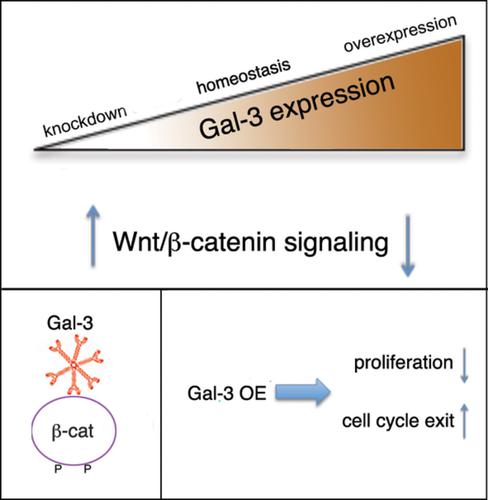当前位置:
X-MOL 学术
›
STEM CELLS
›
论文详情
Our official English website, www.x-mol.net, welcomes your feedback! (Note: you will need to create a separate account there.)
Galectin-3 diminishes Wnt signaling in the postnatal subventricular zone
STEM CELLS ( IF 5.2 ) Pub Date : 2020-05-22 , DOI: 10.1002/stem.3202 Osama Al-Dalahmah 1 , James Nicholson 1 , Swip Draijer 1 , Luana Campos Soares 1, 2 , Francis G Szele 1
STEM CELLS ( IF 5.2 ) Pub Date : 2020-05-22 , DOI: 10.1002/stem.3202 Osama Al-Dalahmah 1 , James Nicholson 1 , Swip Draijer 1 , Luana Campos Soares 1, 2 , Francis G Szele 1
Affiliation

|
Postnatal subventricular zone (pSVZ) stem and progenitor cell proliferation is regulated by several developmental signaling pathways such as Wnt/β‐catenin. However, the molecular regulation of Wnt function in the pSVZ is poorly understood. We previously showed that Wnt signaling is upregulated in an SVZ gliomagenesis in vivo model. As well, the pro‐inflammatory molecule Galectin‐3 (Gal‐3) increases Wnt signaling in cancer cells and is expressed in the SVZ. Therefore, we asked if Gal‐3 has a similar function on Wnt signaling in the pSVZ. We interrogated Wnt signaling using a signaling reporter as well as immunohistochemistry and showed that Wnt signaling predominates upstream in the pSVZ lineage but is downregulated in migrating neuroblasts. Biochemical analysis of SVZ cells, in vivo and in neurosphere stem/progenitor cells, showed that Gal‐3 physically interacts with multiple forms of β‐catenin, which is a major downstream regulator of Wnt signaling. Functional analyses demonstrated, in vitro and in vivo, that Gal‐3 knockdown increases Wnt signaling and conversely that Gal‐3 OE inhibits Wnt/β‐catenin signaling in the pSVZ. This latter result suggested that Gal‐3, which is consistently increased in brain injury, may decrease pSVZ proliferation. We showed that Gal‐3 OE decreased proliferation without altering cell cycle re‐entry and that it increased p27Kip1, a molecule which induces cell cycle exit. Our data uncover a novel regulator of Wnt signaling in the SVZ, Gal‐3, which does so in a manner opposite to cancer.
中文翻译:

Galectin-3 减少出生后脑室下区的 Wnt 信号
出生后脑室下区 (pSVZ) 干细胞和祖细胞增殖受多种发育信号通路如 Wnt/β-catenin 的调控。然而,对 pSVZ 中 Wnt 功能的分子调控知之甚少。我们以前表明 Wnt 信号在 SVZ 胶质瘤体内模型中上调。同样,促炎分子 Galectin-3 (Gal-3) 增加癌细胞中的 Wnt 信号并在 SVZ 中表达。因此,我们询问 Gal-3 是否对 pSVZ 中的 Wnt 信号具有类似的功能。我们使用信号报告基因和免疫组织化学来询问 Wnt 信号,并表明 Wnt 信号在 pSVZ 谱系的上游占主导地位,但在迁移的成神经细胞中被下调。体内和神经球干/祖细胞中 SVZ 细胞的生化分析,表明 Gal-3 与多种形式的 β-catenin 发生物理相互作用,β-catenin 是 Wnt 信号传导的主要下游调节剂。体外和体内功能分析表明,Gal-3 敲低会增加 Wnt 信号传导,相反,Gal-3 OE 抑制 pSVZ 中的 Wnt/β-catenin 信号传导。后一个结果表明,在脑损伤中持续增加的 Gal-3 可能会降低 pSVZ 增殖。我们发现,Gal-3 OE 在不改变细胞周期再进入的情况下减少了增殖,并且它增加了 p27Kip1,一种诱导细胞周期退出的分子。我们的数据揭示了 SVZ 中 Wnt 信号传导的新调节剂 Gal-3,其作用方式与癌症相反。在体外和体内,Gal-3 敲低会增加 Wnt 信号传导,相反,Gal-3 OE 抑制 pSVZ 中的 Wnt/β-catenin 信号传导。后一个结果表明,在脑损伤中持续增加的 Gal-3 可能会降低 pSVZ 增殖。我们发现,Gal-3 OE 在不改变细胞周期再进入的情况下减少了增殖,并且它增加了 p27Kip1,一种诱导细胞周期退出的分子。我们的数据揭示了 SVZ 中 Wnt 信号传导的新调节剂 Gal-3,其作用方式与癌症相反。在体外和体内,Gal-3 敲低会增加 Wnt 信号传导,相反,Gal-3 OE 抑制 pSVZ 中的 Wnt/β-catenin 信号传导。后一个结果表明,在脑损伤中持续增加的 Gal-3 可能会降低 pSVZ 增殖。我们发现,Gal-3 OE 在不改变细胞周期再进入的情况下减少了增殖,并且它增加了 p27Kip1,一种诱导细胞周期退出的分子。我们的数据揭示了 SVZ 中 Wnt 信号传导的新调节剂 Gal-3,其作用方式与癌症相反。我们发现,Gal-3 OE 在不改变细胞周期再进入的情况下减少了增殖,并且它增加了 p27Kip1,一种诱导细胞周期退出的分子。我们的数据揭示了 SVZ 中 Wnt 信号传导的新调节剂 Gal-3,其作用方式与癌症相反。我们发现,Gal-3 OE 在不改变细胞周期再进入的情况下减少了增殖,并且它增加了 p27Kip1,一种诱导细胞周期退出的分子。我们的数据揭示了 SVZ 中 Wnt 信号传导的新调节剂 Gal-3,其作用方式与癌症相反。
更新日期:2020-05-22
中文翻译:

Galectin-3 减少出生后脑室下区的 Wnt 信号
出生后脑室下区 (pSVZ) 干细胞和祖细胞增殖受多种发育信号通路如 Wnt/β-catenin 的调控。然而,对 pSVZ 中 Wnt 功能的分子调控知之甚少。我们以前表明 Wnt 信号在 SVZ 胶质瘤体内模型中上调。同样,促炎分子 Galectin-3 (Gal-3) 增加癌细胞中的 Wnt 信号并在 SVZ 中表达。因此,我们询问 Gal-3 是否对 pSVZ 中的 Wnt 信号具有类似的功能。我们使用信号报告基因和免疫组织化学来询问 Wnt 信号,并表明 Wnt 信号在 pSVZ 谱系的上游占主导地位,但在迁移的成神经细胞中被下调。体内和神经球干/祖细胞中 SVZ 细胞的生化分析,表明 Gal-3 与多种形式的 β-catenin 发生物理相互作用,β-catenin 是 Wnt 信号传导的主要下游调节剂。体外和体内功能分析表明,Gal-3 敲低会增加 Wnt 信号传导,相反,Gal-3 OE 抑制 pSVZ 中的 Wnt/β-catenin 信号传导。后一个结果表明,在脑损伤中持续增加的 Gal-3 可能会降低 pSVZ 增殖。我们发现,Gal-3 OE 在不改变细胞周期再进入的情况下减少了增殖,并且它增加了 p27Kip1,一种诱导细胞周期退出的分子。我们的数据揭示了 SVZ 中 Wnt 信号传导的新调节剂 Gal-3,其作用方式与癌症相反。在体外和体内,Gal-3 敲低会增加 Wnt 信号传导,相反,Gal-3 OE 抑制 pSVZ 中的 Wnt/β-catenin 信号传导。后一个结果表明,在脑损伤中持续增加的 Gal-3 可能会降低 pSVZ 增殖。我们发现,Gal-3 OE 在不改变细胞周期再进入的情况下减少了增殖,并且它增加了 p27Kip1,一种诱导细胞周期退出的分子。我们的数据揭示了 SVZ 中 Wnt 信号传导的新调节剂 Gal-3,其作用方式与癌症相反。在体外和体内,Gal-3 敲低会增加 Wnt 信号传导,相反,Gal-3 OE 抑制 pSVZ 中的 Wnt/β-catenin 信号传导。后一个结果表明,在脑损伤中持续增加的 Gal-3 可能会降低 pSVZ 增殖。我们发现,Gal-3 OE 在不改变细胞周期再进入的情况下减少了增殖,并且它增加了 p27Kip1,一种诱导细胞周期退出的分子。我们的数据揭示了 SVZ 中 Wnt 信号传导的新调节剂 Gal-3,其作用方式与癌症相反。我们发现,Gal-3 OE 在不改变细胞周期再进入的情况下减少了增殖,并且它增加了 p27Kip1,一种诱导细胞周期退出的分子。我们的数据揭示了 SVZ 中 Wnt 信号传导的新调节剂 Gal-3,其作用方式与癌症相反。我们发现,Gal-3 OE 在不改变细胞周期再进入的情况下减少了增殖,并且它增加了 p27Kip1,一种诱导细胞周期退出的分子。我们的数据揭示了 SVZ 中 Wnt 信号传导的新调节剂 Gal-3,其作用方式与癌症相反。



























 京公网安备 11010802027423号
京公网安备 11010802027423号